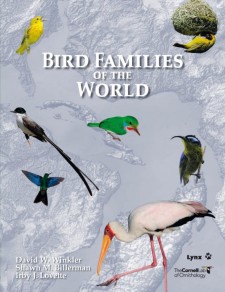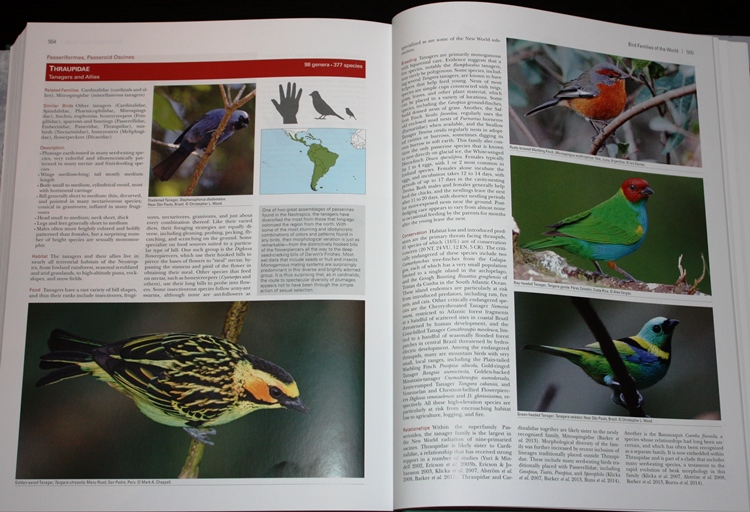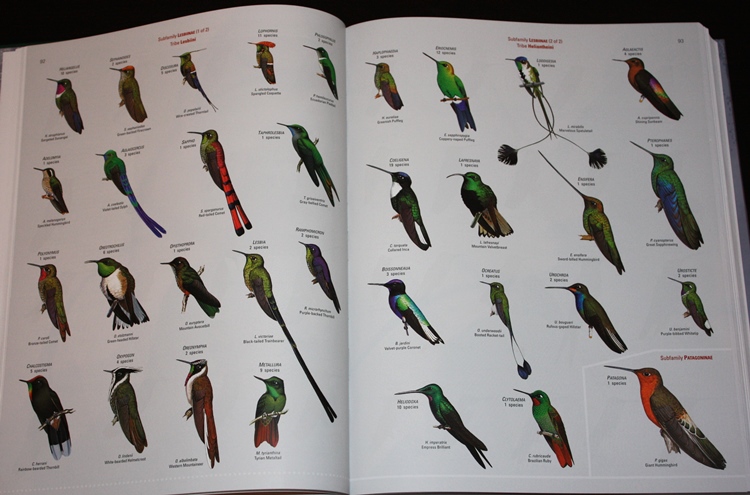Reviewed by Frank Lambert on March 5th, 2016.
Bird Families of the World: A Guide to the Spectacular Diversity of Birds is a robust, one-volume synopsis of the diversity of all birds. Sandwiched between the publication of the two volumes of the HBW and BirdLife International Illustrated Checklist of the Birds of the World, and following in the wake of the widely-acclaimed 17 volumes of the Handbook of Birds of the World (HBW), this book sets out to succinctly describe and illustrate all of the bird families of the world, based on the latest discoveries in avian taxonomy. There are 243 families of living birds (within 36 orders) recognised under the classification used in this new book.
Whilst there have of course been previous books about the world’s bird families, this book is completely up-to-date, an important consideration in view of the rapid and often surprising recent advances in our understanding of the relationships between the world’s 10,000-plus species of bird. The taxonomy adopted here, as one would anticipate, follows closely that in the Illustrated Checklist (of which only the Non-Passerine volume is presently available – the Passerine Volume should be published in late 2016). The only difference that I noted between this book and the Non-Passerine Checklist, with respect to families, is the adoption of a slightly different physical order of families, and recognition of the family Sarothruridae (Flufftails and African Woodrails), which is treated as part of the Rallidae (Rails, Coots and Gallinules) in the Illustrated Checklist (published in July 2014).
Although technical terminology is apparently much reduced – and all scientific terms used are defined in a glossary – some readers may find the introductory chapters a challenge to understand. This introductory material describes the scope and concepts behind the classification used and gives suggestions about how best to use the book. The introduction provides an interesting comparison of where regionally endemic families occur, and of course what these are. The Australasian region comes out top, with 38 endemic families, followed by the Afrotropics (27), Neotropics (24), Oriental region (10), Palearctic (5), and at the bottom, the Nearctic (namely North America, with only one endemic family, the Peucedramidae, represented by a single species – Olive Warbler Peucedramus taeniatus – that in fact only breeds in the Nearctic).
Following the main introduction, there is a short, formal description of three new families, these being Chaetopidae (two species of South African rock-jumpers, or rockjumpers in other parts of the book), the endemic Sulawesi Hylocitreidae (with one species, Olive-flanked Whistler Hylocitrea bonensis), and a new African family, Modulatricidae (Spot-throat Modulatrix stictigula and allies, these being Dapple-chest Arcanator orostruthus and Grey-chested Kakamega Kakamega poliothorax).
But the bulk of this impressive book (527 pages), and the part for which most readers will buy this book and will refer to the most, is the family-by-family account of the birds of the world. For each family there is a distribution map with the breeding, non-breeding, and year-round ranges of each family; brief standardized descriptions of the appearance, relationships, and similar species to each family’s members; a summary of their life history (e.g. habitat, diet and feeding behaviour, and breeding biology); and current conservation status according to BirdLife International. Each family account also includes an up-to-date summary about the relationships of the family to other families as well as relationships internally. The work is generously illustrated by (mostly) high quality photographs, as well as paintings of one species from each of the genera in each family – these derived from other recent works published by Lynx.
The book provides useful statistics on the number of species in each genus within a family, and this family guide follows the taxonomy of the Non-Passerine volume of the Illustrated Checklist, which recognised a staggering 461 new splits (compared to only 21 lumped species). The Passerine volume of the Checklist is likely to recognise significant numbers of new splits as well, but some of those may not be “accounted for” in the stats presented in this family guide.
Bird Families of the World has been designed to serve both as a resource for serious bird enthusiasts of all levels and a text for ornithology courses. Whether you are a birder with an interest in global bird diversity, a professional ornithologist wishing to update and fill-in your comprehensive knowledge of avian diversity, or a lister trying to see representatives of all the world’s bird families, this volume will be a valuable addition to your library.
– Reviewed by Frank Lambert
Editor’s note: here are some of my thoughts on Bird Families of the World.








[…] The Birder’s Library […]
Penguin